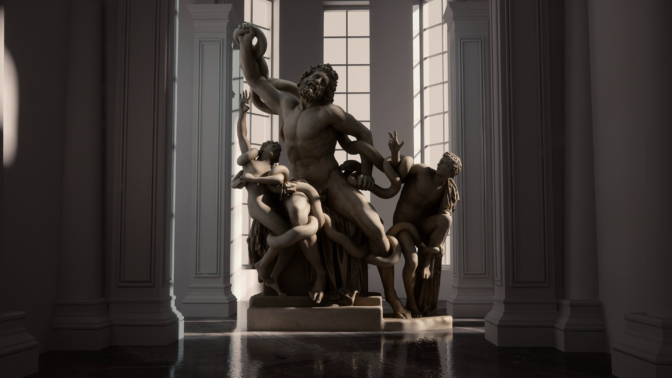Editor’s note: This post is a part of our Meet the Omnivore series, which features individual creators and developers who use NVIDIA Omniverse to accelerate their 3D workflows and create virtual worlds.

Edward McEvenue grew up making claymations in LEGO towns. Now, he’s creating photorealistic animations in virtual cities, drawing on more than a decade of experience in the motion graphics industry.
The Toronto-based 3D artist learned about NVIDIA Omniverse, a 3D design collaboration and world simulation platform, a few months ago on social media. Within weeks he was using it to build virtual cities.
McEvenue used the Omniverse Create app to make a 3D representation of New York City, composed of 32 million polygons:
And for the following scene, he animated a high-rise building with fracture-and-reveal visual effects:
Light reflects off the building’s glass windows photorealistically, and vehicles whiz by in a physically accurate way — thanks to ray tracing and path tracing enabled by RTX technology, as well as Omniverse’s physics-based simulation capabilities.
McEvenue’s artistic process incorporates many third-party applications, including Autodesk 3ds Max for modeling and animation; Epic Games Unreal Engine for scene layout; tyFlow for visual effects and particle simulations; Redshift and V-Ray for rendering; and Adobe After Effects for post-production compositing.
All of these tools can be connected seamlessly in Omniverse, which is built on Pixar’s Universal Scene Description, an easily extensible, open-source 3D scene description and file format.
Real-Time Rendering and Multi-App Workflows
EDSTUDIOS, McEvenue’s freelance company, creates 3D animations and motion graphics for films, advertisements and other visual projects.
He says Omniverse helps shave a week off his average delivery time for projects, since it eliminates the need to send animations to a separate render farm, and allows him to bring in assets from his favorite design applications.
“It’s a huge relief to finally feel like rendering isn’t a bottleneck for creativity anymore,” McEvenue said. “With Omniverse’s real-time rendering capabilities, you get instant feedback, which is incredibly freeing for the artistic process as it allows creators to focus time and energy into making their designs rather than facing long waits for the beautiful images to display.”

McEvenue says he can output more visuals on one computer running Omniverse faster than he previously could with nine. He uses an NVIDIA RTX 3080 Ti GPU and NVIDIA Studio Drivers to accelerate his workflow.
In addition to freelance projects, McEvenue has worked on commercial campaigns across Canada, the U.S. and Uganda as a co-founder of the film production company DAY JOB.
“Omniverse takes away a lot of the friction in dealing with exporting formats, recreating shaders or linking materials,” McEvenue said. “And it’s very intuitively designed, so it’s incredibly easy to get up and running.”
Watch a Twitch stream replay that dives deeper into McEvenue’s workflow, as well as highlights the launch of the Unreal Engine 5 Omniverse Connector:
Join In on the Creation
Creators across the world can download NVIDIA Omniverse for free, and enterprise teams can use the platform for their 3D projects.
Join the #MadeInMachinima contest, running through June 27, for a chance to win the latest NVIDIA Studio laptop.
Learn more about Omniverse by watching GTC sessions on demand — featuring visionaries from the Omniverse team, Adobe, Autodesk, Bentley Systems, Epic Games, Pixar, Unity, Walt Disney Studios and more.
Connect your workflows to Omniverse with software from Adobe, Autodesk, Epic Games, Maxon, Reallusion and more.
Follow Omniverse on Instagram, Twitter, YouTube and Medium for additional resources and inspiration. Check out the Omniverse forums and join our Discord Server to chat with the community.